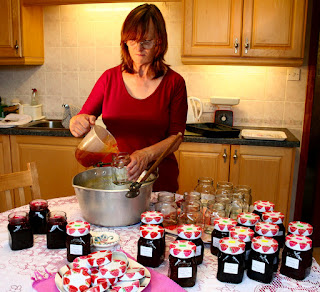FRUIT FOR THE END OF SUMMER
The soft fruit season is just about over other than raspberry, Autumn Bliss which will continue till mid October. If autumn weather is mild they will be fine, but if the cool wet weather continues they will not be sweet and will suffer from botrytis rots. Perpetual strawberry Flamenco will be the same, i.e. it will continue outdoors till the frosts come, but although it may look terrific, it will taste like a turnip without some sunshine. Blackberries will continue well into autumn, with late varieties unaffected by early frosts, but newer varieties bred for tunnel production will rot in a cool wet autumn outdoors. My bramble Helen is very early and finished cropping in August. This year was not a good year for Helen as lack of sunshine and warmth reduced the sugar content of the fruit.
However, although the soft fruit season is ending other fruits are now getting attention.
Cherries. The new dwarfing rootstock Gisela 5 has made a huge difference to growing cherry trees. In the past other rootstocks created a tree too big to cover with a net, and on a garden scale the cherry crop from one tree is a huge target for local blackbirds, who can devour cherries at an alarming speed. My smaller growing cherry Cherokee is only five foot tall and I will train it in a fan shape keeping the height down to about six feet. That way I can protect it with a net. This year I got quite a few cherries though many were split due to wet weather.
Commercially, growers in this area are diversifying onto this new crop and planting them in tunnels to protect them from adverse weather and birds.
Peach Peregrine has finally grown away from the menace of peach leaf curl, but it has been a constant battle cutting out and removing every affected leaf. At one point the tree was almost completely defoliated, but now growth has returned and summer spur pruning is being carried out. This tree was to be fan trained, but the original fan shape has been lost with peach leaf curl disease, so I will start again and try to find a way to sort out its shape. Once again fruit drop has reduced my crop, but there is still about a dozen fruit beginning to colour up.
Apples
This has not been a good year for the Arbroath Pippin (the Oslin) as brown rot has taken one fruit after another. This disease has also affected Discovery and Red Devil, but if you remove affected fruit as soon as you see them you can stop it spreading. This problem is not usually serious in a normal year. However I did get three Oslin apples. They were not as sweet as previous years, but the strong flavour is fantastic. This is an excellent apple, and my next early variety, Discovery also has a wonderful flavour and should be grown commercially in this area. I just hope the supermarkets stock this UK grown apple. George Cave is another early apple with a distinct aromatic flavour well worth growing.
Plums failed this year so nothing to get excited about, and my pears are just completing their second years growth after grafting, so 2013 will be the first year I sample The Christie and Beurre Hardy.
Figs are showing an excellent crop, but they need a wee bit more sunshine to ripen up. Growth has been strong so some summer spur pruning is being done to allow more light into the wall trained bush and encourage next years figs to form. A high potash tomato feed also helps to ripen up the figs. In Scotland they really need a warm sunny south facing wall to succeed outdoors.
Grapes
Outdoor grape Brant has had the third spur pruning to discourage vigorous growth, (cutting back every young shoot to one leaf) and allow sunshine to ripen up the bunches. Glasshouse grapes need constant watching as botrytis can form in bunches that have not been thinned. Remove any grape beginning to rot before it spreads to others. Keep the greenhouse well ventilated and I now remove all new growths as well as some leaves to aid good air circulation around the ripening bunches.
Plant of the week
Angels Trumpet, (Brugmansia) is a large leaved tropical plant from South America with long pendulous flowers in a range of colours. They have a strong exotic perfume especially at night as they are pollinated by a night flying moth. This plant is a tree in its native habitat, but grown here as an ornamental specimen plant in a tub or flower bed. It can be lifted at the end of the growing season and dried off. Store in a cool but frost free place till next spring where it can be brought into a warm greenhouse and started into growth again. Take care with this plant as all parts are very poisonous especially the leaves and seeds. Brugmansia belongs to the same family as the potatoes and deadly nightshade and contains high levels of hallucinogenic alkaloids especially scopolamine and atropine. Traditionally, it was used in South American cultures in medicine and rituals for communicating with the dead as well as a poison in black magic.
END




















